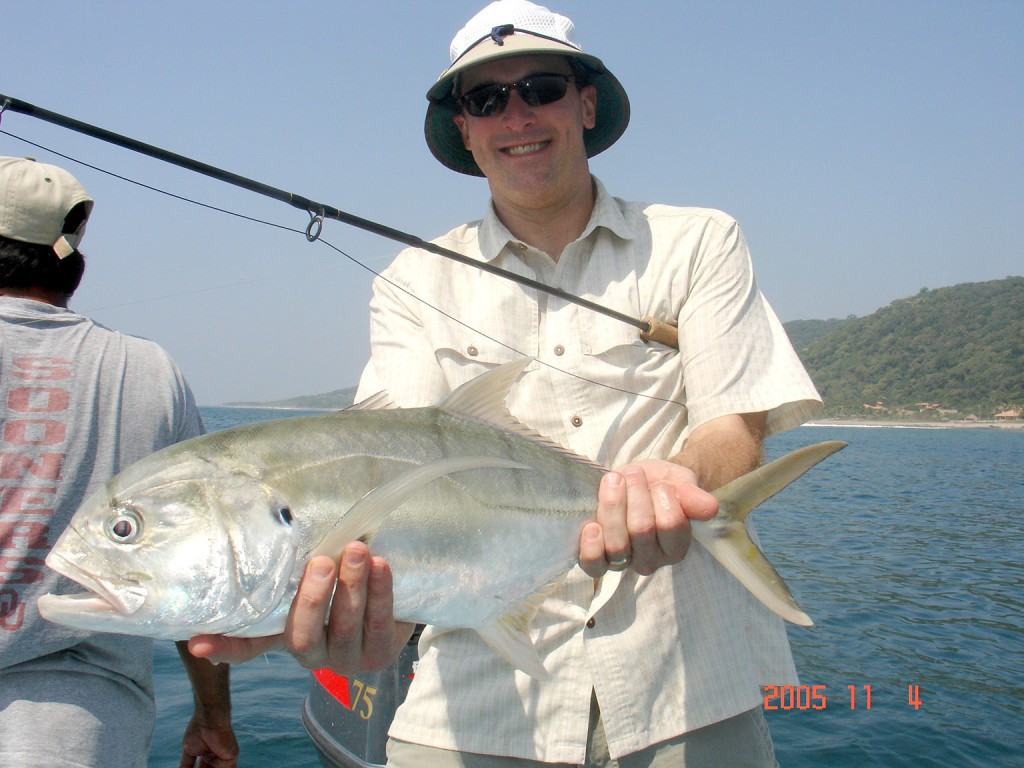March, April and May are some of the best months we have for inshore fishing. When I mean fishing, I am talking about the hard fighting Jack Crevalle. Plus, May through December brings on the incredible roosterfish. For both of these fish, the lighting fast runs, combined with brute strength and a bad attitude, make for a memorable fight for any angler.
When targeting these species in years’ past, the trend was to slow troll a live bait or Rapala type lure. But, this last couple of years has seen a complete reversal of this trend. Due to its effectiveness, casting a surface popper has almost replaced the older methods entirely; or at least to the point of them being a secondary backup.
Besides being very effective for catching roosters and jacks, how has this method become so popular, and what are the advantages?
a) If you are wholly dependent on trolling for roosters and jacks, what happens if live bait is not available? This can happen because last night’s rain would not even allow the bait fishermen to get out. Or, the full moon scattered the bait, and they were almost impossible to find. The popper gives you the ability to not miss a day of fishing, plus the confidence it really works.
b) When non-targeted species are in the area, namely needle fish, they will raise havoc with your live bait. In a short time, you will not have any bait left, and your day will be done. But, with poppers, you can save your live bait for when you want to use it, or when you get out of the area holding the needle fish.
c) Live bait is generally slow trolled behind the boat, but that is not really where the roosters or jacks are. When they are in the feed mode, they are in closer to the shoreline. The boat cannot get in there, because of the dangerous waves. But, a popper can reach clear to the foam on the beach, and cover every foot of water where the fish are actively feeding.
d) The fast rate of casting poppers will allow you to cover more water, have longer casts, and be more effective than trolling or casting live bait. There is nothing wrong with slow trolling live bait, and also have a person on the bow casting with a popper. In fact, it is extremely effective.
e) If you take the hooks off a popper, you have a deadly teaser bait for a fly caster to have a shot at the rooster or jack. There is no way a fly caster is going to make a 150-foot cast from a rocking panga. But, a popper will cast that far, and bring the fish all the way back to within a very reasonable casting distance of less than 40 feet from the boat.
An important note about casting poppers is that you must have quality gear, with the ability to cast long distances. However, do not go out and buy a 15-foot surf rod, just because you heard that people cast a long ways with them. They are set up to cast heavy weights, and will flat out tire you out after a few casts. An ideal outfit is a nine foot to 10 foot light to medium duty salt water rod, with a medium sized salt water spin reel. (A conventional reel will cast a long ways, but the spool diameter is generally not big enough, even with a 5:1 gear ratio, to easily attain the retrieve speed you need). A light action salt water spin reel is easier to cast all day, but be sure to compare the amount of retrieve with a medium sized spin reel first. The greater the retrieve distance, for every complete revolution of the handle, is the one you want. You want that popper to sizzle across the water, with a minimum amount of effort. Otherwise, you will not last more than a couple of hours.
There are two other tricks you can use to get longer casts. Use a 30 or 50 pound braided line. When compared to an equal pound test monofilament line, the new high tech braided lines have a very small diameter. The smaller diameter means less resistance for longer casts, without sacrificing breaking strength. Plus, for those really large fish, you will have more capacity on the reel. If you have not installed a trigger release on your rod, the braided line can shred your fingers. Be sure to wear a casting glove, or at the least, tape up your casting index finger. A bimini twist is the most secure way to form a loop on the braided line, and then use a double loop to loop connection through the swivel eye. Use a drop of magic glue to secure the tag end of the knot. The swivel will then attach to the popper.
A final trick is to take the popper and drill an angled hole in the bottom and near the back. The drill bit should penetrate into the hollow cavity. Then insert a small section of lead into the hole, sealing it off with a hot glue gun. The lead which works the best is the pencil lead; usually attached inside surgical tubing and used in fast current bottom bouncing for steel head. This additional weight will increase your cast distance, and not sacrifice any action.
Poppers need not be limited to the six to eight inch surface poppers which are actually designed for the purpose. Some metal spoons and jigs cast a long distance and splash along on the surface with a fast retrieve. They also can be deadly. However, no matter what style of surface lure you use, make sure it is a heavy duty salt water lure, with heavy duty hooks. Then get ready for the ferocious strike, brutal runs, and bad attitude common to the roosters and jacks.




